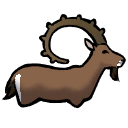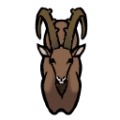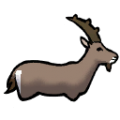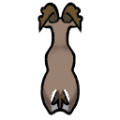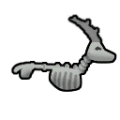Difference between revisions of "Ibex"
| Line 64: | Line 64: | ||
== Taming == | == Taming == | ||
Ibex can be tamed wild from {{Habitats|{{PAGENAME}}|or}}, randomly join your colony in an event, or bought pre-tamed from a trading ship. | Ibex can be tamed wild from {{Habitats|{{PAGENAME}}|or}}, randomly join your colony in an event, or bought pre-tamed from a trading ship. | ||
| + | |||
| + | == Summary == | ||
| + | {{Pen Animal Note|Ibex}} | ||
== Analysis == | == Analysis == | ||
| + | Ibex are one of the best animals to ranch for food and leather. They don't have any utility beyond food production. | ||
| + | |||
| + | ===Nutrition=== | ||
When slaughtered, an ibex yields {{#vardefineecho:baby_meat|{{Meat Leather Curve|{{#expr:{{P|Body Size}}*0.2*140}}}}}} meat and {{Meat Leather Curve|{{#expr:{{P|Body Size}}*0.2*40}}}} leather as a baby; {{Meat Leather Curve|{{#expr:{{P|Body Size}}*0.5*140}}}} meat and {{Meat Leather Curve|{{#expr:{{P|Body Size}}*0.5*40}}}} as a juvenile; or {{Meat Leather Curve|{{#expr:{{P|Body Size}}*140}}}} meat and {{Meat Leather Curve|{{#expr:{{P|Body Size}}*40}}}} leather as an adult. | When slaughtered, an ibex yields {{#vardefineecho:baby_meat|{{Meat Leather Curve|{{#expr:{{P|Body Size}}*0.2*140}}}}}} meat and {{Meat Leather Curve|{{#expr:{{P|Body Size}}*0.2*40}}}} leather as a baby; {{Meat Leather Curve|{{#expr:{{P|Body Size}}*0.5*140}}}} meat and {{Meat Leather Curve|{{#expr:{{P|Body Size}}*0.5*40}}}} as a juvenile; or {{Meat Leather Curve|{{#expr:{{P|Body Size}}*140}}}} meat and {{Meat Leather Curve|{{#expr:{{P|Body Size}}*40}}}} leather as an adult. | ||
| − | An adult ibex | + | An adult ibex consumes {{P|Real Hunger Rate}} nutrition per day, and a female creates up to {{#expr: 1/{{P|Gestation Period Days}} round 2}} offspring per day. |
| + | * When offspring are slaughtered as babies, a female ibex will produce {{#expr:{{Meat Production|{{PAGENAME}}|baby}} round 2}} nutrition of meat per day, giving an optimal nutrition efficiency of {{%|{{Meat Production|{{PAGENAME}}|baby}}/{{P|Real Hunger Rate}} round 3}}. | ||
| + | * If the offspring are allowed to grow to adulthood, they will consume an additional {{#expr:{{Nutrition Consumption|{{PAGENAME}}|adult}} - {{P|Real Hunger Rate}} round 2}} nutrition per day, but will instead yield {{#expr:{{Meat Production|{{PAGENAME}}|adult}} round 2}} nutrition per day as they are slaughtered, resulting in an optimal nutrition efficiency of {{%|{{Meat Production|{{PAGENAME}}|adult}}/{{Nutrition Consumption|{{PAGENAME}}|adult}} round 3}}. | ||
| + | When considering a population of equal numbers of males and females, these nutrition efficiencies fall to {{%|{{Meat Production|{{PAGENAME}}|baby|1|1}}/{{Nutrition Consumption|{{PAGENAME}}|baby|1|1}} round 3}} for baby slaughter and {{%|{{Meat Production|{{PAGENAME}}|adult|1|1}}/{{Nutrition Consumption|{{PAGENAME}}|adult|1|1}} round 3}} for adult slaughter. | ||
| − | + | Ibex are the single most efficient animal to ranch. They are superior to [[horse]]s, [[gazelle]]s, and [[cow]]s, at least for the purposes of food. Certain animals are more nutritionally efficient, but take more work to manage: | |
| + | * [[Tortoise]]s are the best animal for nutrition. However, tortoises are not pen animals, meaning they will eventually untame. They require much more work to maintain their tameness, or need to be micromanaged so that they are always slaughtered just before they run wild. | ||
| + | * When considering different populations of male:females, [[chicken]]s are potentially more ''nutritionally'' efficient. However, they are significantly more work-intensive to slaughter and butcher, and do not yield any leather. | ||
== Training == | == Training == | ||
Revision as of 07:40, 28 February 2023
Ibex
The wild ancestor of the domesticated goat. Ibexes live on marginal territory where most antelopes couldn't survive, eating lichens and sparse mountain plants. They're famous for dextrously hopping across bare cliff faces - and for their violent ramming attack.
Base Stats
- Type
- Animal
- Flammability
- 70%
Pawn Stats
- Move Speed
- 4.6 c/s
- Health Scale
- 85% HP
- Body Size
- 1
- Mass - Baby
- 12 kg
- Mass - Juvenile
- 30 kg
- Mass - Adult
- 60 kg
- Carrying Capacity
- 75 kg
- Filth Rate
- 16
- Hunger Rate
- 0.32 Nutrition/Day
- Diet
- herbivorous
- Life Expectancy
- 15 years
- Manhunter Chance
- 0%
- Manhunter Chance (Taming)
- 0%
- Trainable Intelligence
- None
- Wildness
- 55%
- Minimum Handling Skill
- 4
- Roam Interval
- 2 days
- Mate Interval
- 12 hours
- Maturity Age
- 0.222 years (13.3 days)
- Juvenile Age
- 0.1 years (6 days)
- Comfortable Temp Range
- -30 °C – 40 °C (-22 °F – 104 °F)
Production
- Meat Yield
- 140
 ibex meat
ibex meat - Leather Yield
- 40
 plainleather
plainleather - Gestation Period
- 5.661 days
- Offspring Per Birth
- 1
Melee Combat
- Attack 1
- Front left leg
8 dmg (Blunt)
12 % AP
2 second cooldown - Attack 2
- Front left leg
8 dmg (Poke)
12 % AP
2 second cooldown - Attack 3
- Front right leg
8 dmg (Blunt)
12 % AP
2 second cooldown - Attack 4
- Front right leg
8 dmg (Poke)
12 % AP
2 second cooldown - Attack 5
- Teeth
8 dmg (Bite)
12 % AP
2 second cooldown
0.5 chance factor - Attack 6
- Head
10 dmg (Blunt)
15 % AP
2.6 second cooldown - Average DPS
- 2.46
- tradeTags
- AnimalCommon
The ibex is a large wild goat. Males of the species are called Ibex rams and have large rounded horns and a darker brown color, while females are called ibex does and have shorter, straighter horns and a lighter brown color.
Taming
Ibex can be tamed wild from temperate forests, temperate swamps, boreal forests, cold bogs, or tundra, randomly join your colony in an event, or bought pre-tamed from a trading ship.
Summary
Ibex are pen animals. Once tamed, pen animals cannot and do not need to be trained any further. But if left outside of a pen or caravan hitching spot, pen animals will eventually roam outside your colony. Making a caravan is not required to tie animals to a caravan hitching spot.
Analysis
Ibex are one of the best animals to ranch for food and leather. They don't have any utility beyond food production.
Nutrition
When slaughtered, an ibex yields 31 meat and 16 leather as a baby; 70 meat and 25 as a juvenile; or 140 meat and 40 leather as an adult.
An adult ibex consumes 0.32 nutrition per day, and a female creates up to 0.18 offspring per day.
- When offspring are slaughtered as babies, a female ibex will produce 0.27 nutrition of meat per day, giving an optimal nutrition efficiency of 85.6%.
- If the offspring are allowed to grow to adulthood, they will consume an additional 0.45 nutrition per day, but will instead yield 1.24 nutrition per day as they are slaughtered, resulting in an optimal nutrition efficiency of 161.3%.
When considering a population of equal numbers of males and females, these nutrition efficiencies fall to 42.8% for baby slaughter and 113.8% for adult slaughter.
Ibex are the single most efficient animal to ranch. They are superior to horses, gazelles, and cows, at least for the purposes of food. Certain animals are more nutritionally efficient, but take more work to manage:
- Tortoises are the best animal for nutrition. However, tortoises are not pen animals, meaning they will eventually untame. They require much more work to maintain their tameness, or need to be micromanaged so that they are always slaughtered just before they run wild.
- When considering different populations of male:females, chickens are potentially more nutritionally efficient. However, they are significantly more work-intensive to slaughter and butcher, and do not yield any leather.
Training
This animal can be trained as follows:
| Guard: | |
|---|---|
| Attack: | |
| Rescue: | |
| Haul: | |
*As of version 1.1.2610, all animals can be tamed. The percentage of likelihood of success depends on factors such as the Animals Wildness Percentage, Pawn Handling Skill, and others. More information can be found on the animals page.
